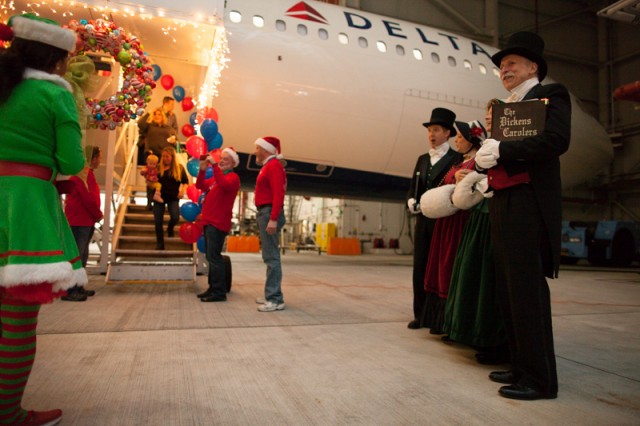
Carolers greet families as they deboard the jet at the “North Pole”
Earlier this week, Delta Air Lines offered a very special charter flight to the North Pole with VIP guests. Children and families of the Down Syndrome Community of Puget Sound boarded a specially decorated Airbus A330 at Seattle-Tacoma International Airport before being whisked away on a quick trip to a winter wonderland.
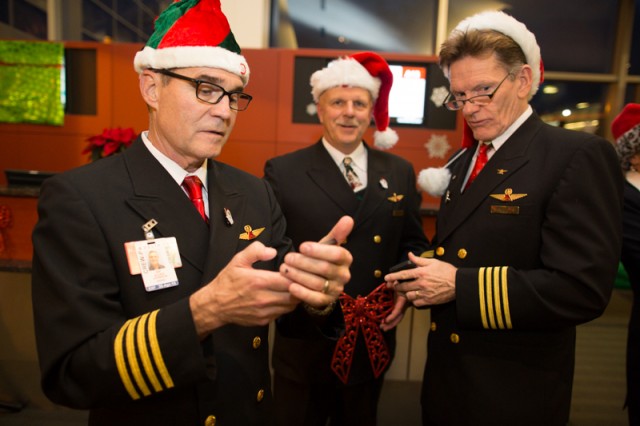
The pilots for Delta flight 1225, service from Seattle to the North Pole, check emails before the flight.
Upon arrival, the guests were treated to different games, entertainment, Blitz from the Seattle Seahawks, the Coca-Cola Polar Bear and of course Santa, who took some time out of his busy schedule to interact.
We had photographer Jeremy Dwyer-Lindgren there to cover the event and afterwards he said, “I have to say that it was one of the heartwarming three hours I’ve had in awhile.” He was excited to share the experience via some photos.
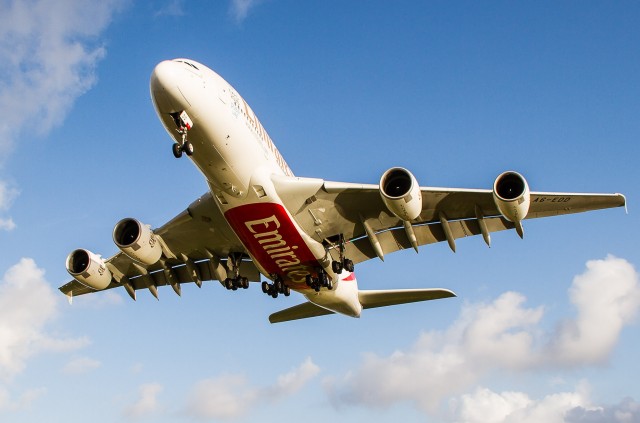
Emirates A380 short final at Sydney – Photo: Jacob Pfleger | AirlineReporter
EMIRATES AIRLINE FIRST CLASS REVIEW BASICS:
Airline: Emirates Airline
Aircraft: Airbus A380-800
Departed: Sydney (SYD)
Arrived: Dubai (DXB)
Stops: Non-stop flight
Class: First Class
Seat: 2A
Length: About 14 hours
Not many people I know get too excited at the prospect of a 14-hour flight that leaves at 6:00 AM. But when travelling in first class, even the 4:00 AM wake-up call is cause for excitement. I was recently fortunate enough to experience the first class product on-board Emirates’ A380 from Sydney to Dubai.
Most Emirates’ departures from Australia to Dubai are timed to leave at night; this did not appeal very much to me as when traveling first class I like to make the most of the experience, rather than just sleep though it. Luckily, Emirates had recently introduced the A380 product on their EK415 service, which departs Sydney at 6:00 AM with a 1:20 PM arrival to Dubai. This service is primarily targeted at connecting traffic onto the afternoon European services, which allow for a same-day evening arrival into Europe.
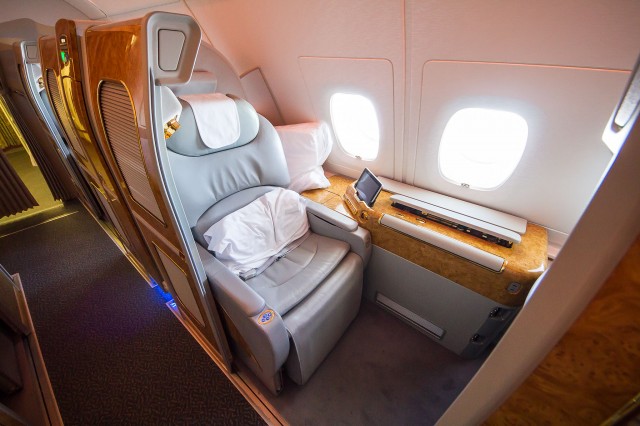
Emirates A380 first class suite; not a bad place to spend 14 hours – Photo: Jacob Pfleger | AirlineReporter
I was happy to be staying at an airport hotel, meaning that I could afford to sleep in a little longer. Check-in at Sydney was completed with minimal fuss, and I was on my way to security within five minutes of entering the terminal.
Given the Qantas Emirates partnership, first class passengers traveling on Emirates flights have access to the Qantas First Class Lounge at Sydney. Sadly, the lounge was still closed at this hour of the morning. I had to make do with the Emirates lounge – while it is still of a very high standard, it is not as good as the Qantas’ first lounge.
On board, I was welcomed by the purser and escorted to my seat. As this was my first time flying Emirates First Class, I was given a very comprehensive walk-through of all of the seat and cabin features. At this time, I also received my bvlgari amenity kit along with pajamas and slippers; all of this was very nicely presented in an Emirates-branded tote bag. This is probably the best and highest quality of in-flight amenities I have received on any carrier.
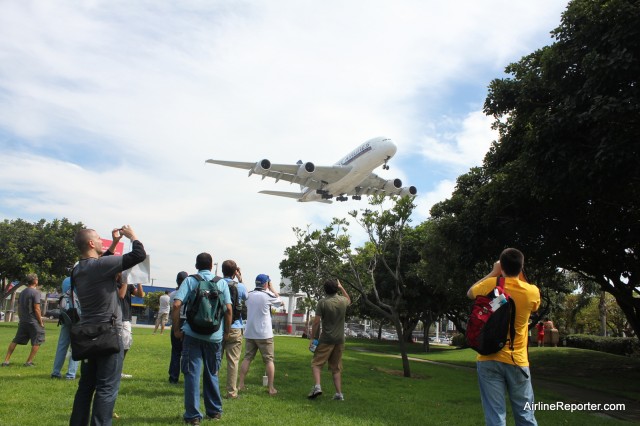
Singapore
Hello AvGeeks!
We thank those of you who keep reading, interacting, and supporting all of us at AirlineReporter. As most of you, know we are more than just a website, but use different forms of social media as ways for you to connect, learn, and enjoy more.
Since we have added some new things in the past few weeks, we wanted to remind you of our other sources and ask that you add/follow us! Here they are:
Thanks for your support!
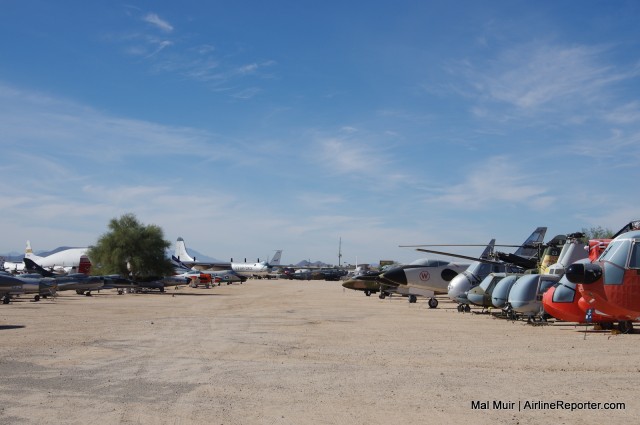
A look down one of the “streets” in the outdoor portion of the Pima Air & Space Museum
Tucson, Arizona is home to the University of Arizona and also Raytheon Missile systems. Those two companies, along with the US Air Force, form the largest three employers in the city. However, Tucson is also home to a unique AvGeek attraction, one that will astound any true aviation fan.
The Pima Air & Space Museum is located about a five-minute drive from Tucson airport and on the boundaries of Davis Montham Air Force Base. The museum is the largest privately funded aviation museum in the world, yes’¦ the world.
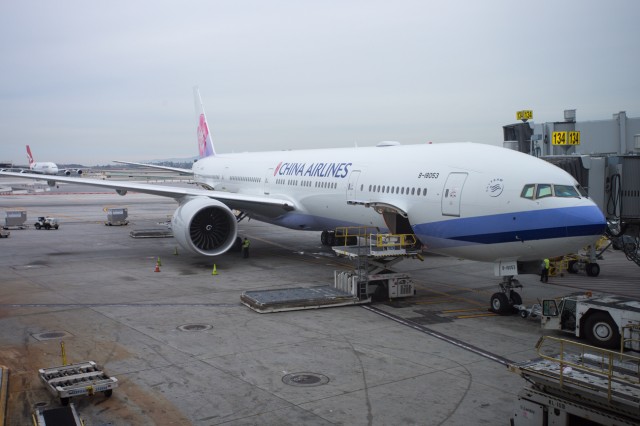
China Airlines’ Boeing 777-300ER – Photo: Jeremy Dwyer-Lindgren
When China Airlines unveiled its new Boeing 777-300ER back in early October of this year, it was clear that this airplane was something special. Photos and videos of the new interioroutfitted with a snazzy new business cabin, homages to Taiwanese culture, and a small libraryquickly made the internet rounds, establishing this plane as the hot new item in the air.
Having seen it myself in Seattle, I knew it had to try it once it was released into the wild. Fast forward two months to last Monday (December 1), when I found myself, ticket in hand, ready to board China Airlines flight 5, service from Los Angeles LAX to Taipei. AirlineReporter/NYCAviation were invited by the airline to sample the carrier’s promising-looking new business class. The formal adventure began in the lounge at Los Angeles International Airport.
China Airlines (CAL), does not have one of its own at the airport, and thus utilizes Korean’s SkyTeam lounge instead. As far as lounges go, this one runs above average, largely thanks to its new-ness and an exterior deck overlooking the main hall. I helped myself to a few finger sandwiches and a beverage while checking email on the free WiFi. Boarding began on time at gate 134. Holding a ticket for the carrier’s premium business class, I boarded quickly via a dedicated jet-way connected to the L1 door.
Those with business tickets are split between two cabins, and today’s seat22Awas in the rear section nestled behind the L2 door. Both cabins are set up in a reverse herringbone style in a 1-2-1 configuration. As boarding continued, cabin crew offered a selection of non-alcoholic pre-flight drinks and hot towels. Bags and personal items slipped easily into overhead bins or into one of three built-in storage areas in the seat. The giant Boeing 777-300ER easily lifted off runway 25R and turned northwest to head up the California coast for the scheduled 14-hour flight to Taipei’s Taoyuan International Airport.






